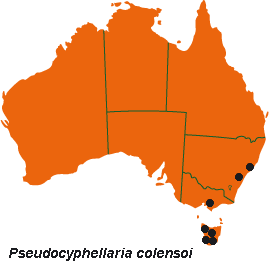



Australian Biological Resources Study
| Checklist of the Lichens of Australia and its Island Territories | ||
| Introduction | A–D | E–O | P–R | S–Z | Oceanic Islands | References | ||
| Pseudocyphellaria colensoi (C.Bab.) Vain. | ||
| Résult. Voy. Belgica, Lich. 28 (1903); Sticta colensoi C.Bab., in J.D.Hooker, Fl. Nov. Zel. 2: 274 (1855). T: New Zealand, J.D.Hooker; lecto: BM, fide D.J.Galloway & P.W.James, Lichenologist 12: 294 (1980); syn: BM. | ||
| Thallus rosette-forming to irregularly spreading, loosely attached centrally, 8–20 (–30) cm wide. Lobes linear-elongate to broadly rounded, irregularly incised or notched, discrete at margins, imbricate centrally, 5–10 (–12) cm long, 10–25 (–30) mm wide; lobe margins crenulate, torn or ragged to deeply incised, often eroded yellow- or orange-red, pseudocyphellate below, sparsely to densely isidiate. Upper surface pale grey-green to tawny when dry, lettuce-green to blue-green when wet, pitted, wrinkled, shallowly to deeply faveolate, often cracked, matt or glossy to ±scabrid in parts, ±evenly isidiate. Isidia nodular at first, then granular-coralloid, often densely clustered, eroding yellow. Medulla yellow, often appearing patchily orange-red (e.g. at surface cracks). Photobiont green. Lower surface pale yellow at margins, darkening centrally, thinly tomentose. Pseudocyphellae conspicuous, yellow. Apothecia pedicellate, submarginal and laminal, 1–2 (–10) mm diam.; disc pale to dark red-brown, matt, epruinose; exciple isidiate; epithecium pale yellow-brown, K–; hypothecium colourless to pale straw-yellow or yellow-brown. Ascospores 1–3-septate, oval-ellipsoidal or broadly fusiform, 30–35 (–40) × 9–11 μm, colourless to pale yellow-brown. CHEMISTRY: Pulvinic acid, pulvinic dilactone, calycin, polyporic acid, 2α,3β,22α-triacetoxystictane, 22α-hydroxystictane-3-one, 2α,3β-diacetoxystictane-22-ol, stictane-3β,22α-diol, 2α-acetoxy-stictane-3β,22α-diol, 3β-acetoxystictane-2α,22α-diol and stictane-2α,3β,22α-triol. |  |
|
| Occurs in eastern N.S.W., Vic. and Tas. at altitudes of 600–1300 m. Also common and widespread in New Zealand. | ||
| Galloway et al. (2001) | ||
| Checklist Index |
| Introduction | A–D | E–O | P–R | S–Z | Oceanic Islands | References |
This work is copyright. Apart from any use as permitted under the Copyright Act 1968, no part may be reproduced by any process without prior written permission from Australian Biological Resources Study. Requests and inquiries concerning reproduction and rights should be addressed in the first instance to Dr P. McCarthy. These pages may not be displayed on, or downloaded to, any other server without the express permission of ABRS.